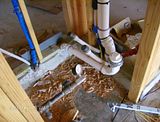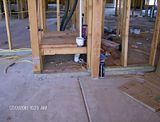In Oklahoma they call this a high maintenence p-trap; because the homeowner has to make sure the trap doesn't go dry;
HVAC in attic; condensate disposal. At the top of the picture you will see the HVAC drain pan line inserted into the trap drain line;
(right click to enlarge)

Here is another. You cannot see the P-trap because it is under the slab. The drain line with the cleanout plug is used for the water heater T&P discharge line. Again, the trap must be kept full by the homeowner, to prevent sewer gases from entering the building;
(right click on the picture to enlarge)

By the way; there is no vent on this drain. The other drain line in the picture is not connected to the one with the cleanout.
In this picture you will see the drain line from the attic HVAC unit to the high maintenence trap drain line. The water heater T&P discharge will be added when the water heater is installed. Again, no vent for trap; and the p-trap drain line can be as far as twenty (20) feet to the main drain under the slab.

Do ya'll see this where you are?
This normal all over Oklahoma,
Uncle Bob
HVAC in attic; condensate disposal. At the top of the picture you will see the HVAC drain pan line inserted into the trap drain line;
(right click to enlarge)

Here is another. You cannot see the P-trap because it is under the slab. The drain line with the cleanout plug is used for the water heater T&P discharge line. Again, the trap must be kept full by the homeowner, to prevent sewer gases from entering the building;
(right click on the picture to enlarge)

By the way; there is no vent on this drain. The other drain line in the picture is not connected to the one with the cleanout.
In this picture you will see the drain line from the attic HVAC unit to the high maintenence trap drain line. The water heater T&P discharge will be added when the water heater is installed. Again, no vent for trap; and the p-trap drain line can be as far as twenty (20) feet to the main drain under the slab.

Do ya'll see this where you are?
This normal all over Oklahoma,
Uncle Bob
Last edited by a moderator:
